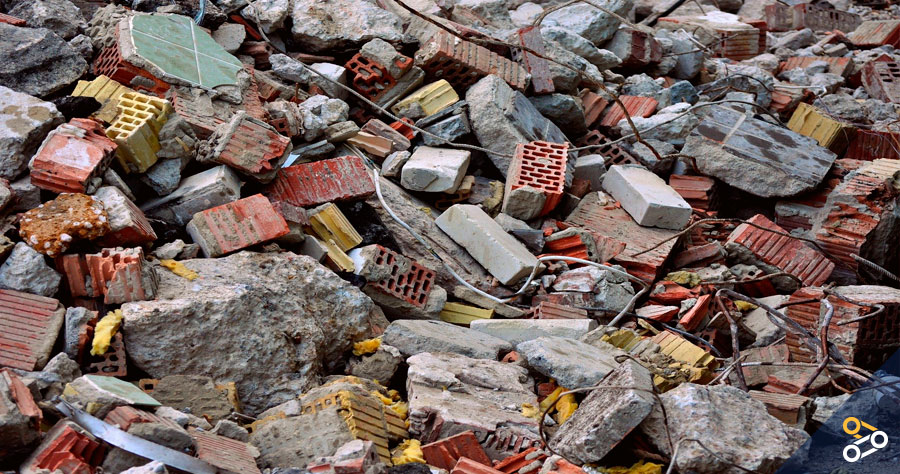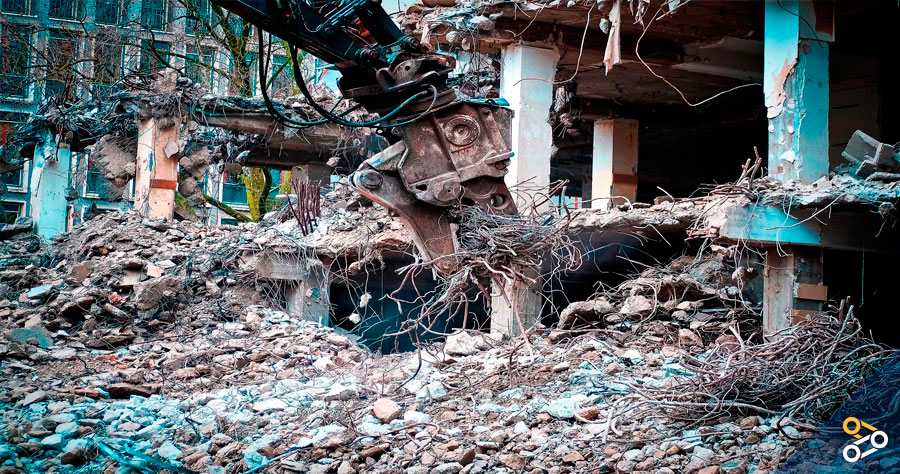Construction and Demolition Waste represents the largest waste stream within the European Union, representing a third of the total waste generated. Proper management of these not only brings sustainability benefits but will also have a positive impact on the construction and recycling industry.
70% of construction and demolition waste (RCD) must undergo management and recovery processes within the strategy included in the EU 2030 strategy.

What is construction and demolition waste?
RD105/2008, de 1 de febrero, on which the production and management of construction and demolition waste is regulated, understands by construction and demolition waste the substances or objects that, complying with the definition of “Waste” are generated in:
- The construction, rehabilitation, repair, reform or demolition of a real estate, such as a building, road, port, airport, railway, canal, dam, sports or leisure facility, as well as any other civil engineering analog.
- Carrying out work that modifies the shape or substance of the land or subsoil, such as excavations, injections, housing developments or other similar, excluding those activities to which Directive 2006/21 / EC of the European Parliament and of the Council, of March 15, on the management of waste from extractive industries.
What are their characteristics?
Generally 60-70% of the general composition of RCDs are mineral materials (earth, concrete, bricks, ceramics), the rest making up variable amounts of wood, metal, plaster, plastics, etc. Most of it is non-hazardous waste, even inert, the use of which should not present problems but can contribute to reducing the consumption of natural mineral resources. Hazardous waste can also be generated on site and must be collected and treated separately by sending it to authorized managers.
The mixture of hazardous and non-hazardous waste is expressly prohibited in the waste regulations since, in addition to posing a risk to human health and the environment, it can cause a large volume of non-hazardous waste to become hazardous waste, giving lead to more complex and costly management.
What is your MANAGEMENT CYCLE and how should they be treated?
In general, in order to achieve a significant appreciation of RCD, the following conditions must be met:
- Classification at source or, alternatively when there is no possibility of doing it on site, in classification plants, by types of materials, particularly concrete, ceramics, wood, metals, plastic, paper and cardboard.
- Have a recycling infrastructure (in general, recovery) at adequate distances for the waste generated (sorting plants, recycled aggregate manufacturing plants, reject dumps for RCDs not treated or resulting from a previous treatment process).
- Have channels for the selective collection of the fractions of wood, metal, plastic, paper and cardboard separated on site or in sorting plants, which transfer said fractions to recyclers, generally valorisers, of these materials; and a sustained demand for these fractions by recycling / recovery companies.

At JLM Ingeniería we have in our products three options for the recovery and treatment of construction and demolition waste (RCD). The treatment plant mod. Rec100 , a modular set of easy handling, transport and installation, and the mobile equipment mod. TR100E_Compact and TR200E_Compact. In addition, thanks to our experience in the sector, we can offer you a wide range of tailor-made solutions according to your treatment needs.

What are the APPLICATIONS of recycled materials?
Thanks to improvements in the management of construction and demolition waste, they have more and more applications. In the construction sector, they are used in a wide variety of areas such as earthworks, solid road layers or in the manufacture of concrete, among other applications.
Applications are highly dependent on the nature of the waste and its composition. To disseminate these applications, the Ministry of Development-Ministry of has developed a Catalog of Usable Waste in Construction.
The Catalog is accessible through the Internet.
Source: Miteco



